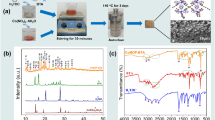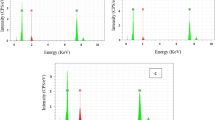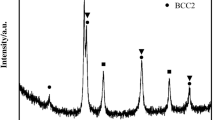Abstract
Mg alloys were anodized in alkaline NaOH solutions with various additives as a non-chromate method. Specimen AZ91 was anodized at a potential that produced a strong surface dissolution reaction and generated a large amount of Mg(OH)2. The effect of sealing after anodizing was investigated, focusing on the effects of sealing time, temperature and solution conditions. The current density decreased with increasing A1(OH)3 concentration in 1 M NaOH solution during anodizing; sparking occurred at potentials above 80 V. The best corrosion resistance with anodizing in 1 M NaOH solution occurred at a potential of 4 V, which caused the strongest active dissolution reaction. The sealing effect improved with increasing time and temperature, and corrosion resistance was proportional to the relative ratio of Mg(OH)2. If the oxygen thickness observed by EDX equaled the film thickness, the film formed at 4 V in 1 M NaOH was 10–15 Μm thickness. The optimum corrosion resistance in sealing at various solutions after anodizing was 1M-NaOH solution.
Similar content being viewed by others
References
Altenphol, D. G.,Corrosion,18, 43 (1962).
Wood, G. C. and O’Sullivan, J. P.,“Electron-optical Examination of Sealed Anodic Alumina Films: Surface and Interior Effects,”J. Electrochem. Soc,116, 1351 (1969).
Hasumi, A., Itoi, T. and Sato, E.,“Anodic Oxidation of Magnesium in Sodium Aluminate Solution,”J. Japan Institute of Light Metals,30, 437 (1980).
Hwang, S. K., Jeong, S. H., Hwang, H. Y., Lee, O. J. and Lee, K. H., “Fabrication of Highly Ordered Pore Array in Anodic Aluminum Oxide,”Korean J. Chem. Eng.,19, 467 (2002).
Murpy, J. F.,“Symposium on Anodizing,”Aluminum, 3 (1967).
Kawase, H.,“Studies on Effects of Electrolytic and Sealing Conditions on Anodic Oxide Films on Aluminum Studies on Sealing of Anodic Oxide Films of Aluminum (1st report),”J. Japan Institute of light Metals,21, 12 (1971).
Kawase, H.,“Effects of Small Amounts of Anions Contained in Sealing Solution for Anodic Oxide Films,”J. Japan Institute of Light Metals,21, 120(1971).
Khaselev, O. and Yahalon, J.,“The Anodic Behavior of Binary Mg-Al Alloys in KOH-Aluminate Solutions,”Corros. Sci.,40, 1149 (1998).
Kim, S. J., Okido, M., Mizutani, Y., Ichino, R., Tanikawa, S. and Hasegawa, S.,“Formation of Anodic Films on Mg-Al Alloys in NaOH Solutions at Constant Potentials,”Materials Transactions,44, 1036 (2003).
Kim, S. J., Mizutani, R., Ichino, R., Okido, M. and Tanikawa, S.,“The Electrochemical Properties and Formation Mechanism of Anodic Oxide Films on Mg-Al Alloys,”Bulletin of the Korean Chemical Society,24, 975 (2003).
Kim, S. J., Okido, M., Mizutani, Y. and Ichino, R.,“Yazawa International Symposium, Metallurgical and Materials Processing: Principles and Technologies, Aqueous and Electrochemical Processing,”TMS,3, 31 (2003).
Koda, M., Takahashi, H. and Nagatama, M.,“Reaction of Porous Anodic Oxide Films on Aluminum with Hot Water I. Effect of Film thickness and Reaction Time on the Degree of Hydration and Acid-Dissolution Characteristics,”J. of the Surface Finishing Society of Japan,33, 242 (1982).
Koda, M., Takahashi, H. and Nagayama, M.,“Reaction of Porous Anodic Oxide Films on Aluminum with Hot Water V. Effect of Additives in Hot Water on the Hydration Behavior,”J. of the Surface Finishing Society of Japan,36, 27 (1985).
Mizutani, Y., Kim, S. J., Ichino, R. and Okido, M.,“Anodizing of Mg Alloys in Alkaline Solutions,”Surface and Coatings Technology,169-170, 143 (2003).
Mizutani, Y., Kim, S. J., Ichino, Y. and Okido, M.,“Anodizing of Mg Alloys in Alkaline Solutions,” Frontiers of Surface Engineering 2001 (6th ASEF, AEPSE 2001, 5th APIC, and 4th JKSPTFT) Conference and Exhibition, Nagoya Japan, 178 (2001).
Mizutani, Y., Kim, S. J., Ichino, R., Okido, M., Tanikawa, S. and Hasegawa, S.,“Anodizing of Mg-Al Alloys and Film Characterization” Japan Institute of Light Metals, 102nd Annual Meeting Proceeding, 179 (2002).
Ono, S., Kijima, H. and Masuko, N.,“Microstructure and Voltage-Current Characteristics of Anodic Films Formed on Magnesium in Fluoride Electrolytes,”J. Japan Institute of light Metals,52, 115 (2002).
Ono, S., Kijima, H. and Masuko, N.,“Effects of Substrate Composition and Aluminum Ion Addition on the Formation Voltage-Current Relation for Anodizing of Aluminum,”J. of the Surface Finishing Society of Japan,51, 1168 (2000).
The Institute of Japan Magnesium,“Handbook of Advanced Magnesium Technology,” Kallos Publishing Co., LTD, 311 (2000).
Author information
Authors and Affiliations
Corresponding author
Rights and permissions
About this article
Cite this article
Kim, SJ., Kim, JI. & Okido, M. Sealing effects of anodic oxide films formed on Mg-Al alloys. Korean J. Chem. Eng. 21, 915–920 (2004). https://doi.org/10.1007/BF02705540
Received:
Accepted:
Issue Date:
DOI: https://doi.org/10.1007/BF02705540




